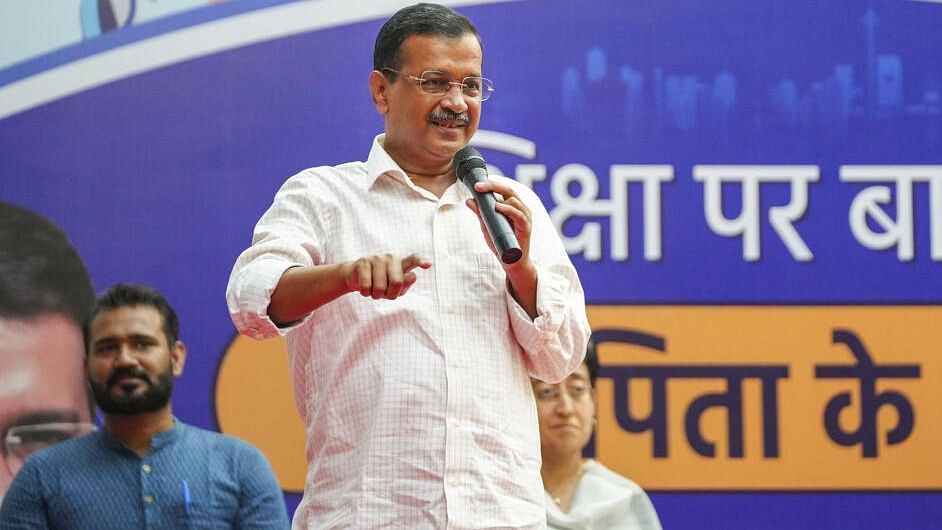
AAP National Convener Arvind Kejriwal.
Credit: PTI Photo
Less than two months before the Election Commission of India is expected to call Assembly elections for Delhi, on November 8 the Congress launched a month-long Delhi Nyay Yatra campaign from Rajghat, aimed to cover all 70 seats. Two days later, veteran politician from Northeast Delhi and five-time MLA, Chaudhary Mateen Ahmed, joined the Aam Aadmi Party (AAP), ending almost three-decades-long association with the Congress.
The Congress is aiming to score big by flagging the liquor policy 'scam'. It is making this attempt with the aid of two large balloon-shaped liquor bottles with obvious slogans written and carried along with the yatra. In this context, Ahmed’s acceptance of AAP chief, Arvind Kejriwal’s public embrace could not have been more inopportune for the Congress.
With this poll-eve crossover, Ahmed, who carries considerable clout within the city’s minorities, categorically neutralised the Congress jibe at AAP’s national convener who spent months in Tihar jail in a case connected to the controversial deal his government cut.
Ahmed’s defection to AAP was not unexpected; a fortnight ago, his son and daughter-in-law joined AAP raising speculations that the party’s sitting MLA, Abdul Rehman from one of Delhi’s constituencies with significant Muslim presence on its northeastern fringe bordering Uttar Pradesh, would be dropped.
Such conjectures surfaced because the last time Ahmed won an election in 2013, was from the same constituency that Rehman, a newcomer, bagged in 2020. Kejriwal’s turn to Ahmed points to AAP leader’s awareness that to ensure majority for the third time, the party cannot be solely dependent on Kejriwal and must pack the team with local leaders having individual bases too.
Seelampur was among badly affected areas in the 2020 communal riots in the capital city. It is important for AAP to prevent Muslim vote being divided between it and the Congress. So far Rehman has not quit AAP — indicating he is dwarfed by Ahmed within the community — but resigned from the party’s minority wing to protest the induction of the Ahmeds.
With five-time MLA Ahmed joining AAP, and several more expected within its ranks soon — including from the Bharatiya Janata Party (BJP) — the party expects this to bolster its prospects in Northeast Delhi and other Muslim-dominated seats. These constituencies also have significant presence of people from lower-middle and working classes, who are the traditional voters of AAP.
But, AAP is not the only party being considered as a green pasture by aspirants. A significant local Sikh leader, Harsharan Singh Balli, crossed over from AAP to the Bharatiya Janata Party (BJP), a party he represented previously in the Assembly. Balli, also the industries minister in Delhi’s first government in the early 1990s, with his crossover may succeed in enlisting Sikh votes, present in significant numbers in Western Delhi, his region of influence too, into the BJP’s support base.
The shifting loyalties of Ahmed and Balli are indicative of co-existence of old-style politics (and vintage political leaders) in Delhi after the dilution of AAP’s preference for new faces.
The fact that Kejriwal reached out to the former Congress legislator although defeated in the last two elections, even relegated to third position behind AAP and BJP candidates, suggests that proxy candidates will not ensure victory in the impending polls.
Quite clearly, AAP expects voters in Delhi to be more circumspect than in 2015 and 2020 when AAP won 67 and 62 seats respectively, out of the 70 Assembly seats.
After the 2013 Assembly elections, voters in Delhi followed the norm of Modi at the Centre and Kejriwal in the state; the BJP swept all seven Lok Sabha seats in 2014, 2019, and 2024 (the last time despite AAP and Congress forging an alliance) while the Kejriwal-led party secured stunning majorities in 2015 and 2020. The question in 2025 is elementary: would the same pattern be followed, or will AAP be jolted by the BJP?
By raking up the liquor ‘scam’, the BJP hopes to have successfully blemished Kejriwal’s image as crusader against corruption. AAP, however, hopes that with little headway in investigations and tardy court proceedings, with all arrested AAP leaders granted bail, including Satyendar Jain, accused of personal misdemeanour, the BJP’s tactics would be seen as misuse of investigating agencies.
The BJP also has a leadership crisis. Since 2015, when it went into the polls with Kiran Bedi as a chief ministerial face, it did not project anyone else. After this year’s Lok Sabha polls, it was weighed if the BJP would project Smriti Irani. While the possibility of her or another high-profile BJP leader being projected exists, time is running out for the party.
Moreover, by resigning as chief minister and anointing Atishi to the post, Kejriwal resorted to political theatrics, a strategy he is adept in, since AAP’s formation. The BJP sought to take down Kejriwal by depicting the anti-corruption champion as a crooked pretender.
But, he turned the tables by stepping down and placing a time-bar to becoming chief minister again — till his acquittal. Given that the disposal of these cases soon are unlikely, whether acquitted or pronounced guilty (although chances of this are very slim), it appears that Kejriwal has begun preparing for the future — in the post-Modi era and at a national level.
For that, he must first ensure AAP’s return to power with an emphatic victory. For the Modi-BJP combine, success in turning tables on AAP will restore the balance within the Sangh parivar in their favour.
For the Congress, a credible performance is important to retain relevance in India’s capital
(Nilanjan Mukhopadhyay, a Delhi-based journalist, is author of 'The Demolition, The Verdict and The Temple: The Definitive Book on the Ram Mandir Project'. X: @NilanjanUdwin.)
Disclaimer: The views expressed above are the author's own. They do not necessarily reflect the views of DH.